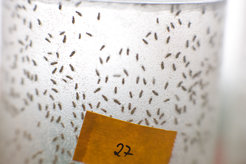
Animal keeping
Most of the animals used in our experiments are bred at the institute. The remaining portion comes from other research institutes or from specialized breeders who are monitored by the relevant authorities. The housing of animals in our animal facilities is based on the very latest scientific knowledge in the field of laboratory animal science. Highly trained and experienced animal keepers, together with veterinarians and biologists, ensure that the animals are held under conditions that comply with animal welfare regulations and meet the varying needs of the different animal species. To keep our high standards in animal keeping we have our own trainee program for animal caretakers. The accommodation provided for the animals reflects their species-specific requirements. For example, mice are held in family or sibling groups insofar as there are no medical or experimental reasons opposing this. Cages provide opportunities for withdrawal and activity; particular attention is paid to hygiene as the basic way of ensuring that the animals remain healthy.
Meticulous animal keeping ultimately serves the interests of science: useful scientific results can only be obtained from animal experiments that are carried out with healthy animals kept in stress-free and species-appropriate conditions.
The breeding and keeping of the animals as well as the experiments are monitored by the institute's animal welfare officer, and by the relevant authorities. To ensure that the animals suffer as little stress as possible, the scientists plan the experiments in cooperation with the institutes’ animal laboratory manager and animal welfare officer.
Mice keeping

Mice held in our animal facility live in groups. The young are separated from their mothers after weaning and are kept in groups of the same sex. Only mature males that have mated with a female often have to be isolated, as they then become so dominant that they can no longer be kept in a group.
Mice are kept in see-through plastic cages with an area of at least 370 square centimetres. Three to six mice live in each cage, depending on their weight. The cages are 14 centimetres high and are covered by a grating, which the animals use for climbing. The cages contain a feed trough and water bottle.
Each cage contains litter of wood shavings or chips. Small hiding places made of red, transparent plastic – known as mouse houses − serve as retreats. Paper strips, excelsior or hemp provide material for nest building and activity. A standardized complete feed in pellet form that provides all the required nutrients and water are freely available.
Husbandry and breeding of the turquoise killifish

The African turquoise killifish is the shortest lived vertebrate species bred in captivity. The fish are raised in 2.8 liters tanks with a defined salt concentration, water pH and a constant temperature of 28 °C. They are raised at a light-dark cycle of 12 hours. A constant water change, which is maintained via a centralized water-filtration system, limits the amount of germs entering the fish tanks. The fish are fed twice per day with live red mosquito larvae (blood worm) and brine shrimp.
The breeding of the turquoise killifish mimics the natural living conditions of this fish in nature. In Africa these fish live in ponds that contain water only for a few months during the rainy season. When the ponds dry out, the embryos survive in a state of suspended animation, called diapause. In the laboratory, after harvesting, embryos are kept for one week in a solution called methylene blue, which limits the growth of fungi. Then they spend 3-4 weeks in an incubator at 28 °C on a dry substrate. The hatched fish are initially kept in small tanks of 0.8 liters volume and are fed only brine shrimps, until they are transferred to larger tanks after one week.
Fruit flies - Husbandry

Fruit flies live in precisely controlled conditions in climatic chambers in our animal holding units. For optimum growth, they need a temperature of 25 degrees, 65 percent humidity and a day/night cycle of twelve hours. The flies are kept in small plastic or glass containers, which are closed by means of a gas permeable bung, made of foam or cotton.
The bottom of the vessel is covered with food for the flies. Although they are termed "fruit flies", Drosophila does not feed on vegetable elements but on the yeast cells living on the fruit. The flies are therefore given standardized blends of yeast and sugar.
Our researchers examine the insects in specially equipped fly laboratories. In order to analyze them, they anaesthetize them with carbon dioxide and sort them under a microscope by their sex or external characteristics. In addition, there are numerous tests with which scientists can observe the insects' fitness and behaviour.
One example is the so-called climbing test, which exploits the fact that flies usually walk in an upward direction. In this test, the flies are knocked to the bottom of the vessel. Scientists then measure how quickly they walk back up again. As their climbing speed decreases with age or in the event of dementia, this enables the effect of a drug or food component to be observed.
Nematode Caenorhabditis elegans - keeping and breeding

The worm Caenorhabditis elegans (C. elegans) belongs to the family of nematodes and lives mainly in the soil. It feeds on soil bacteria and is only about one millimeter in size.
In the lab, the researchers grow it on an agar plate seeded with E. coli bacteria at a constant temperature of 20°C. The worms are hermaphrodites, which means they can fertilize themselves. They lay up to 300 eggs during their lifetime, which lasts only two to three weeks. The larvae develop from the fertilized egg within half a day and after another 40 hours the animals are fully grown. Since eggs and larvae are transparent, each individual cell and its divisions can be observed live under the microscope. The animals are true survival experts and can be stored for decades at -80°C and revived after thawing.



